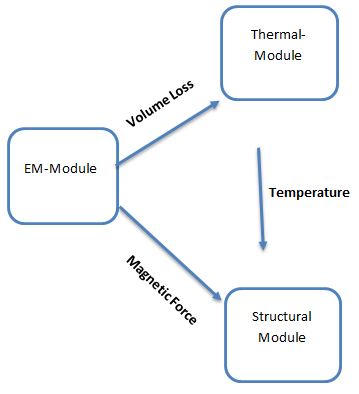Structural Coupling in EMWORKS
Structural Coupling in EMWORKS
Structural coupling in EMWORKS links electromagnetic solvers with mechanical stress/deflection analysis. It lets you transfer electromagnetic forces, pressures, and losses to a structural or thermal–structural model to evaluate deformation, stress, and fatigue.
Typical use:
Map magnetic, electric, or Lorentz forces from EM analysis onto solid bodies
Compute resulting displacement, stress, strain, and safety factors
Assess stiffness, deformation, and contact behavior under electromagnetic loading


Features of Structural Coupling with EMWORKS
Electromagnetic → structural load transfer
Map magnetic, electric, or Lorentz forces and pressures from EM analysis onto solid bodies or assemblies.Static and modal stress analysis
Compute displacement, stress, strain, safety factor, and natural frequencies under electromagnetic loading.Thermo-mechanical coupling
Use EM losses (J·E, core loss, dielectric loss) as heat sources and evaluate thermally induced deformation and stress.Multiphysics workflow
Electromagnetic → thermal → structural chaining in one environment for consistent geometry, mesh, and materials.Material and geometry checks
Compare alternative materials and cross-sections against stress limits, stiffness targets, and fatigue constraints.
Applications of Structural Coupling
Typical use cases:
Electric machines (motors, generators)
Magnetic forces on teeth, yokes, and rotors; deformation, vibration, and noise risk.Transformers and reactors
Core and winding forces under load, inrush, and short-circuit; clamping stress and tank loading.Solenoids and actuators
Plunger/armature forces, contact impact, and housing deformation during operation.Busbars, conductors, and rails
Electrodynamic forces under fault currents; mechanical support and bracing requirements.Magnetic bearings and levitation systems
Stiffness, deflection, and stress in rotor and stator parts under electromagnetic loads.High-power and HV equipment
Structural impact of electromagnetic forces and thermal expansion in switchgear, HV terminals, and clamps.
Results of Structural Coupling with EMWORKS
After running a study with the structural solution option, the following structural quantities can be visualized:
Displacement
Ux : Displacement in x direction
Uy : Displacement in y direction
Uz : Displacement in z direction
Ur : The resultant displacement
Stress
Von Mises Stress
SXX : Normal stress in the X direction
SYY : Normal stress in the Y direction
SZZ : Normal stress in the Z direction
SXY : Shear stress in the Y in the YZ plane
SYZ : Shear stress in the Z in the XZ plane
SZX : Shear stress in the Z in the YZ plane
PS1 : First principal stress
PS2 : Second principal stress
PS3 : Third principal stress
Stress intensity (P1-P3)
Strain
Von Mises Strain
EXX : Normal strain in the X direction
EYY : Normal strain in the Y direction
EZZ : Normal strain in the Z direction
EXY : Shear strain in the Y in the YZ plane
EYZ : Shear strain in the Z in the XZ plane
EZX : Shear strain in the Z in the YZ plane
PE1 : First principal strain
PE2 : Second principal strain
PE3 : Third principal strain
Tresca
Reaction Force
RFX : Reaction Force in the X direction
RFY : Reaction Force in the Y direction
RFZ : Reaction Force in the Z direction
3D Safety Factor
Von Mises Stress Failure Criterion
Maximum shear stress Failure Criterion
Maximum Normal Stress Failure Criterion
Mohr Coulomb Failure Criterion

